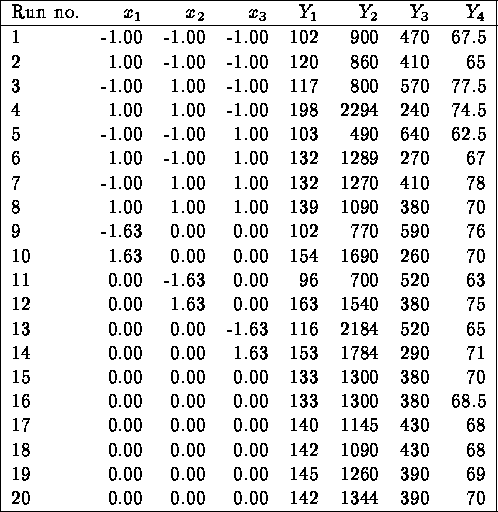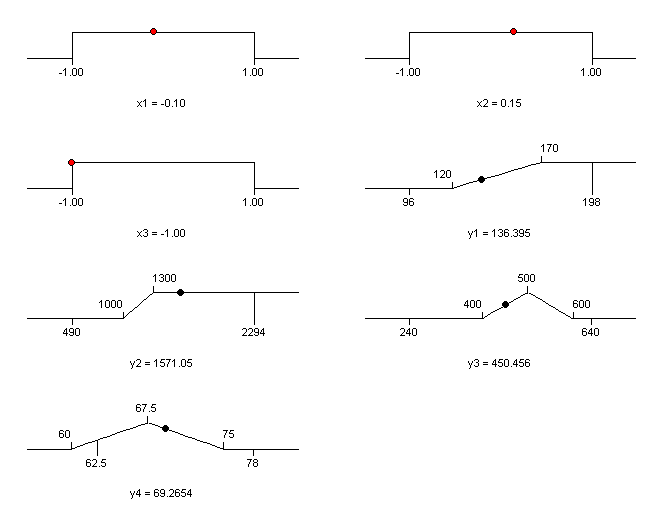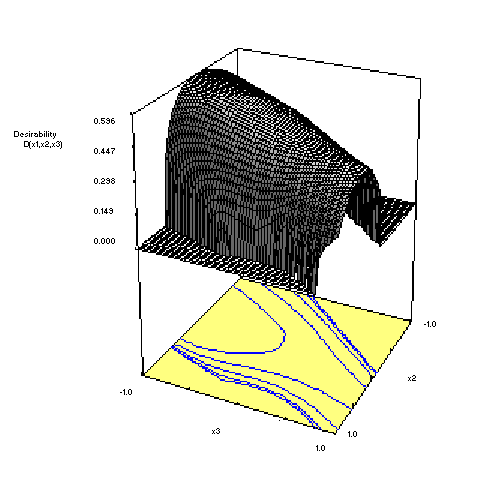5.5. Advanced topics
5.5.5. How do you optimize a process?
5.5.5.2. Multiple response case
5.5.5.2.2. |
Multiple response: The desirability approach |
Desirability approach steps
An example using the desirability approach
 that provide the "most desirable'' response values.
that provide the "most desirable'' response values.
For each response  ,
a desirability function
,
a desirability function  assigns numbers between 0 and 1 to the possible values of
assigns numbers between 0 and 1 to the possible values of  ,
with
,
with  representing
a completely undesirable value of
representing
a completely undesirable value of  and
and  representing
a completely desirable or ideal response value. The individual desirabilities
are then combined using the geometric mean, which gives the overall
desirability D:
representing
a completely desirable or ideal response value. The individual desirabilities
are then combined using the geometric mean, which gives the overall
desirability D:

where k denotes the number of responses. Notice that if
any response i is completely undesirable  then the overall desirability is zero. In practice, fitted response models
then the overall desirability is zero. In practice, fitted response models  are used in the method.
are used in the method.
Depending on whether a particular response  is to be maximized, minimized, or assigned to a target value, different
desirability functions
is to be maximized, minimized, or assigned to a target value, different
desirability functions  can be used. A useful class of desirability functions was proposed by Derringer
and Suich (1980). Let
can be used. A useful class of desirability functions was proposed by Derringer
and Suich (1980). Let  and
and  be the lower,
upper, and target values desired for response i, where
be the lower,
upper, and target values desired for response i, where  .
If a response is of the "target is best'' kind, then its individual desirability
function is
.
If a response is of the "target is best'' kind, then its individual desirability
function is

where the exponents s and t determine how strictly the
target value is desired. For s = t =1, the desirability function
increases linearly towards  ,
for s<1, t<1, the function is convex, and for s>1, t>1,
the function is concave (see the example below for
an illustration).
,
for s<1, t<1, the function is convex, and for s>1, t>1,
the function is concave (see the example below for
an illustration).
If a response is to be maximized instead, the individual desirability is instead defined as

where in this case  is interpreted as a large enough value for the response. Finally, if we
want to minimize a response, we could use
is interpreted as a large enough value for the response. Finally, if we
want to minimize a response, we could use

where  represents
a small enough value for the response.
represents
a small enough value for the response.
The desirability approach consists of the following steps:
- Conduct experiments and fit response models for all k responses;
- Define individual desirability functions for each response;
- Maximize the overall desirability D with respect to the controllable factors.
Derringer and Suich (1980) present
the following multiple response experiment arising in the development of
a tire tread compound. The controllable factors are :  ,
hydrated silica level,
,
hydrated silica level,  ,
silane coupling agent level, and
,
silane coupling agent level, and  ,
sulfur level. The four responses to be optimized and their desired ranges
are:
,
sulfur level. The four responses to be optimized and their desired ranges
are:

The first two responses are to be maximized, and the value s=1
was chosen for their desirability functions. The last two responses are
"target is best'' with  and
and  . The values s
= t =1 were chosen in both cases. The following experiments were conducted
according to a central composite design.
. The values s
= t =1 were chosen in both cases. The following experiments were conducted
according to a central composite design.

Using ordinary least squares and standard diagnostics, the fitted responses were:
![]()
![]()
(adj.  );
);
![]()
![]()
(adj.  );
);

(adj  );
);
![]()
![]()
(adj.  ).
).
Note that no interactions were significant for response 3, and that the fit for response 2 is quite poor.
Optimization of D with respect to  was carried out using the Design Expert software. Figure 5.7 shows the
individual desirability functions
was carried out using the Design Expert software. Figure 5.7 shows the
individual desirability functions  for each of the four responses. The functions are linear since the values
of s and t were selected equal to one. A dot indicates the
best solution found by the Design Expert solver.
for each of the four responses. The functions are linear since the values
of s and t were selected equal to one. A dot indicates the
best solution found by the Design Expert solver.

FIGURE 5.7 Desirability Functions and Optimal Solution
for Example Problem
The best solution is  and results in
and results in
![]()
![]()
and  . The overall
desirability for this solution is 0.596. All responses are predicted to
be within the desired limits.
. The overall
desirability for this solution is 0.596. All responses are predicted to
be within the desired limits.
Figure 5.8 shows a 3D plot of the overall desirability function  for the
for the  plane when
plane when  is fixed at -0.10. The function
is fixed at -0.10. The function  is quite "flat'' in the vicinity of the optimal solution, indicating that
small variations around
is quite "flat'' in the vicinity of the optimal solution, indicating that
small variations around  are not predicted to change the overall desirability drastically. However,
it should be emphasized the importance of performing confirmatory runs
at the estimated optimal operating conditions. This is particularly true
in this example given the poor fit of the response models (e.g.
are not predicted to change the overall desirability drastically. However,
it should be emphasized the importance of performing confirmatory runs
at the estimated optimal operating conditions. This is particularly true
in this example given the poor fit of the response models (e.g.  ).
).


